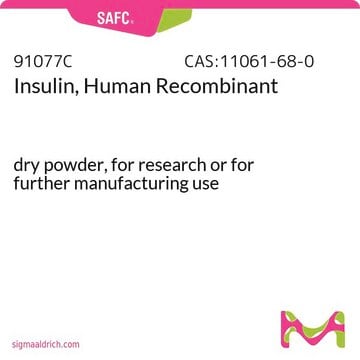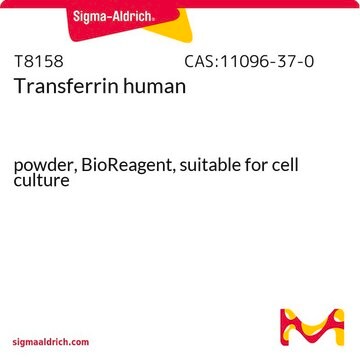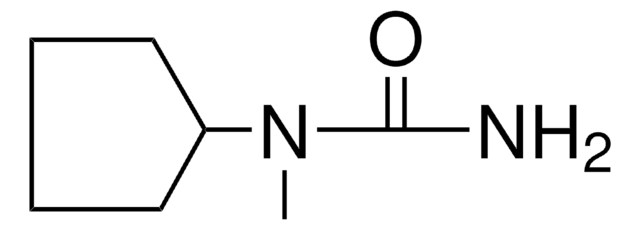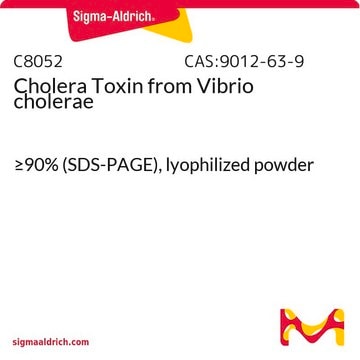This product is prepared from recombinant human insulin produced in Saccharomyces cerevisiae.
I9278
Insulin -Lösung human
sterile-filtered, BioXtra, suitable for cell culture
About This Item
Empfohlene Produkte
Sterilität
sterile-filtered
Qualitätsniveau
Produktlinie
BioXtra
Form
solution
Konzentration
9.5-11.5 mg/mL
Methode(n)
cell culture | mammalian: suitable
Verunreinigungen
≤50 EU/mL endotoxin
pH-Wert
7.9-8.5
UniProt-Hinterlegungsnummer
Lagertemp.
2-8°C
InChIKey
PBGKTOXHQIOBKM-FHFVDXKLSA-N
Angaben zum Gen
human ... INS(3630)
Allgemeine Beschreibung
Anwendung
Humane Insulinlösung wird für Insulintoleranztests bei Mäusen und Ratten verwendet.[1][2] Es wird auch zur adipogenen Differenzierung von aus humanen embryonalen Stammzellen (hESC) gewonnenen Auswuchskulturen und hMSC (humane mesenchymale Stromazellen) verwendet.[3][4]
Biochem./physiol. Wirkung
Sonstige Hinweise
Physikalische Form
Sie haben nicht das passende Produkt gefunden?
Probieren Sie unser Produkt-Auswahlhilfe. aus.
Ähnliches Produkt
Lagerklassenschlüssel
12 - Non Combustible Liquids
WGK
WGK 2
Flammpunkt (°F)
Not applicable
Flammpunkt (°C)
Not applicable
Hier finden Sie alle aktuellen Versionen:
Analysenzertifikate (COA)
Die passende Version wird nicht angezeigt?
Wenn Sie eine bestimmte Version benötigen, können Sie anhand der Lot- oder Chargennummer nach einem spezifischen Zertifikat suchen.
Besitzen Sie dieses Produkt bereits?
In der Dokumentenbibliothek finden Sie die Dokumentation zu den Produkten, die Sie kürzlich erworben haben.
Kunden haben sich ebenfalls angesehen
Protokolle
Discover our collection of primary human hepatic Kupffer cells and protocol for thawing, plating, and growing Kupffer cells. Find the formulation for Kupffer culture maintenance media.
Discover our primary human hepatocytes and plating and maintenance media formulations. Explore our protocol for plateable primary hepatocyte cell culture.
Discover our protocol for thawing, plating, and forming hepatocyte spheroids from human spheroid-qualified plateable hepatocytes. Find the formulation for hepatocyte spheroid maintenance media.
Verwandter Inhalt
Explore our protocol for suspension primary hepatocyte cell culture. Discover our primary human hepatocytes and plating and maintenance media formulations.
-
How is this insulin produced? In E.Coli? Yeast?...?
1 answer-
Helpful?
-
-
Is this product suitable for insulin tolerance tests in mice
1 answer-
This item has not been specifically tested for suitability in insulin tolerance. However, the product has been used successfully in a number of published papers. Please see the link below to review one such article:
https://pmc.ncbi.nlm.nih.gov/articles/PMC2785638/Helpful?
-
-
How long does the insulin remain potent for if stored in the fridge?
1 answer-
This product is assigned an expiration date of approximately 2 years from the date of Quality Release, when stored as directed at 2-8°C. The expiration date is lot specific and reported on the product label, as well as the Certificate of Analysis. Please see the link below to review a sample or lot specific Certificate:
https://www.sigmaaldrich.com/product/sigma/i9278#product-documentationHelpful?
-
-
Is this insulin considered of fast or slow action?
1 answer-
This product is intended for research use only and is not a Therapeutic insulin. The research grade insulin products are not defined by the Therapeutic types. There are analytical standards available for each type. Please see the links below to review additional product options for research use:
Insulin Glargine - Slow acting Insulin
https://www.sigmaaldrich.com/search/insulin-glargine?focus=products&page=1&perpage=30&sort=relevance&term=insulin%20glargine&type=productAspart Insulin - Fast acting Insulin
https://www.sigmaaldrich.com/search/insulin-aspart?focus=products&page=1&perpage=30&sort=relevance&term=insulin%20aspart&type=productLispro Insulin - Fast acting Insulin
https://www.sigmaaldrich.com/search/insulin-lispro?focus=products&page=1&perpage=30&sort=relevance&term=insulin%20lispro&type=productHelpful?
-
-
Is this human insulin suitable for use in mouse cell culture?
1 answer-
Yes, this product is suitable for mouse cell culture and has been cell culture tested on the L929 and 3T3 mouse cell lines. Please see the link below to review peer-reviewed articles that may be of interest:
https://www.ncbi.nlm.nih.gov/pmc/articles/PMC6892261/#:~:text=This%20process%20requires%20DRAM%2D1,and%20permitting%20efficient%20mTORC1%20activation.Helpful?
-
-
what is the morality of the product I9278, Insulin solution human?
1 answer-
The molarity of a 10 mg/mL solution of human insulin, with a molecular weight of 5807 daltons, is approximately 1.7 μmol/mL or 1.7 mM.
Helpful?
-
-
What kind of solution is the insulin (Product number: I9278) dissolved in?
1 answer-
The insulin (cat# I9278) is dissolved in HEPES solution.
Helpful?
-
-
Are there any contaminants (IgG, IgM example) in I9278?
1 answer-
Unfortunately, this product is not tested for impurities.
Helpful?
-
-
What is the content of the insulin solution/buffer (any perservatives and non insulin components?)
1 answer-
This product is prepared in a HEPES buffer, pH 7.9 - 8.5.
Helpful?
-
-
Can you store this product aliquoted at -20 degrees to extend shelf-life?
1 answer-
For research applications, freezing insulin solution has been a common pratice. However, solutions available on the commercial market for therapeutic use are never frozen, in order to maintain maximum activity. There have been no stability studies perform on the shelf life of frozen insulin solutions. Please see the link below to review a publication that may be helpful:
https://www.ncbi.nlm.nih.gov/pmc/articles/PMC8721649/Helpful?
-
Active Filters
Unser Team von Wissenschaftlern verfügt über Erfahrung in allen Forschungsbereichen einschließlich Life Science, Materialwissenschaften, chemischer Synthese, Chromatographie, Analytik und vielen mehr..
Setzen Sie sich mit dem technischen Dienst in Verbindung.













